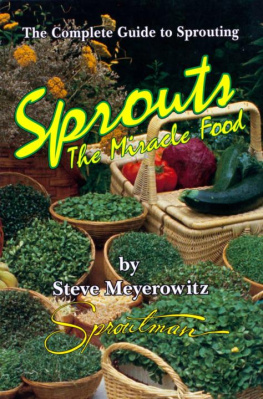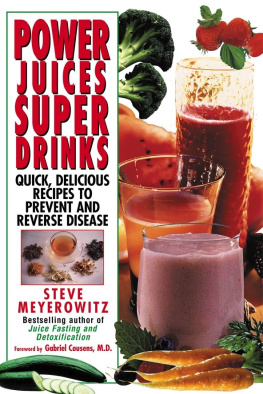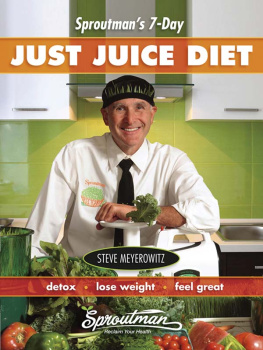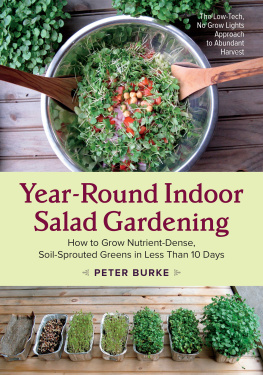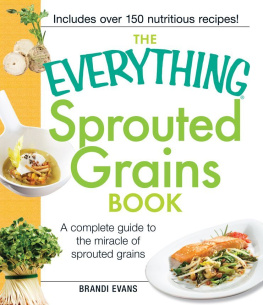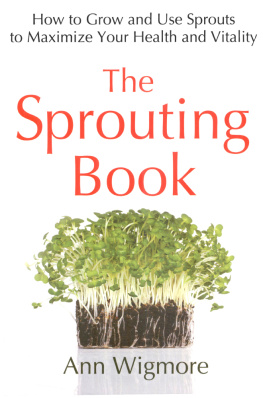by Steve Meyerowitz
Let Your Kitchen Be Your Garden The Agriculture of Tomorrow is Here TodayTM
Illustrations by Michael Parman




God Bless Ann Wigmore and Viktoras Kulvinskas, Prophets of Health and Spirit Whose Teachings Have Given Birth to a New Generation of Healers
INTRODUCTION
9 Vertical Germination
THE TECHNIQUE
GROWING GRAINS & BEANS
AFTER THEY'VE GROWN
SEEDS
NUTRITION
EARTH & WATER
The Seasoned Sprouter
When your teeth crush an apple, say to it in your heart: Your seeds shall live in my body, And the buds of your tomorrow shall blossom in my heart, And your fragrance shall be my breath, And together we shall rejoice through all the seasons - Kablil Gibran
Not all of us can be gardeners. But we all eat. Fact is, if you don't grow your own, someone has to do it for you. Not a bad concept, but in reality, we're on the losing end. A trip to the supermarket proves it. The lettuce is lifeless; the spinach is wilting and dark around the edges. You don't dare eat the fruit for fear of fumigants, fertilizers, pesticides and the like. As a nation, we're eating less and less of the healthiest foods on the planet--fresh fruit and vegetables. Where are the fruits and vegetables? For the most part, you'll find them in the canned food aisle. No wonder kids grow up never liking their vegetables! Of course, you could shop at the health food store. But organic produce sometimes cost more than you want to spend-if you can find it at all. Unfortunately, we don't all live in southern California and we don't all have the time or means to garden.
Here's where apartment gardening comes in. Every week a new harvest of fresh baby greens matures right in your own kitchen. No tools to buy, no big investment in garden equipment, no bugs or weather to worry about and no dirt. One pound of indoor lettuce takes up just 9 inches of counter-top space and one actual minute of care per day. Just dip and set. Light is no problem--normal daylight is all you need. For such little effort, the possibilities are magnificent--30 delicious varieties of fresh, nutritious indoor greens and baby vegetables, enough to feed the whole family!

I got over a life-long struggle with allergies and asthma by revamping my diet. The first thing I did was eliminate the chemically tainted produce I was bringing home from the supermarket. How could anyone ever get well with invisible ingredients like DDT, EDB, Aldicarb and Chlordane hidden in their food? But it's more than that. It's what they don't have... nutrition. Mass market agricultural techniques rob the soil of minerals and substitute synthetic fertilizers and hormones. Zinc, for example, is no longer adequately supplied in the U.S. diet. As a consequence, the American male suffers from the world's highest incidence of prostate cancer and malfunction. Whatever vitamins these vegetables do have is diminished more and more with each day they sit wilting on grocery store shelves. If you had a choice, would you regularly eat food grown 3,000 miles from where you live?

Since I lived in an apartment, I learned to garden indoors. Before long I was dining on crisp Chinese cabbage, luscious crimson clover, hearty sunflower, succulent buckwheat lettuce, spicy red radish, velvety kale, sweet green pea--I had so much, I fed all my friends and students. These young greens were so alive and scintillating with color and aroma, you could practically feel their vitamins! Make no mistake about it. That vitality is assimilated by you--in the form of live enzymes, vitamins, amino acids, trace minerals, RNA, DNA, oxygen and other secret elements about which only nature knows. You can't buy that nutrition in a pill!

If you garden indoors, you effectively reduce your dependence on distant sources for food, energy and technology. Don't think the greenhouse effect is just something that exists in newspapers. Global warming, air pollution, oil spills and acid rain all damage our health as a nation and directly threaten the quality and availability of our food. Drought, flood, heat wave, freeze, increase the price of food as does the rising price of gasoline that is needed to transport it. Our system of over industrialized, long distance, imported, chemically laden, synthetically fertilized and artificially processed foods has got to stop. Either we change it or it will change us. But what can we do about it? Fortunately, you are not completely at the mercy of the giant agri-business industry. You can take steps to become more selfsufficient. Indoor gardening is your answer and it's easier than you think.
How easy is it? The seeds do all the growing. Your only job is to water them one minute per pound per day (30 seconds in the morning, 30 seconds in evening). No weeds to weed, no pests to fence out, no bugs, no soil. It takes less time than standing on line at the supermarket! Only 5 tablespoons of seed, costing only 15-30 cents, yields a full pound of sprouted greens. Where else can you find a comparable source of fresh, nutritious food at that price? Whether you live in Metropolis on the 30th floor or in Alaska, whether it's January or July, you can have fresh food and lots of it year-round.

